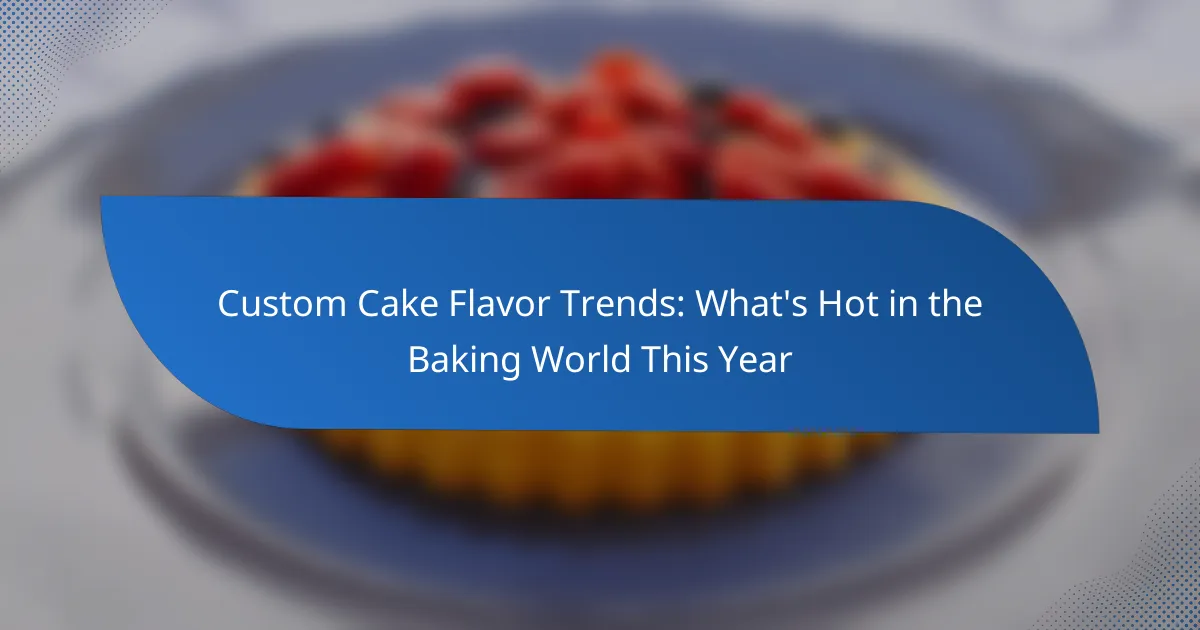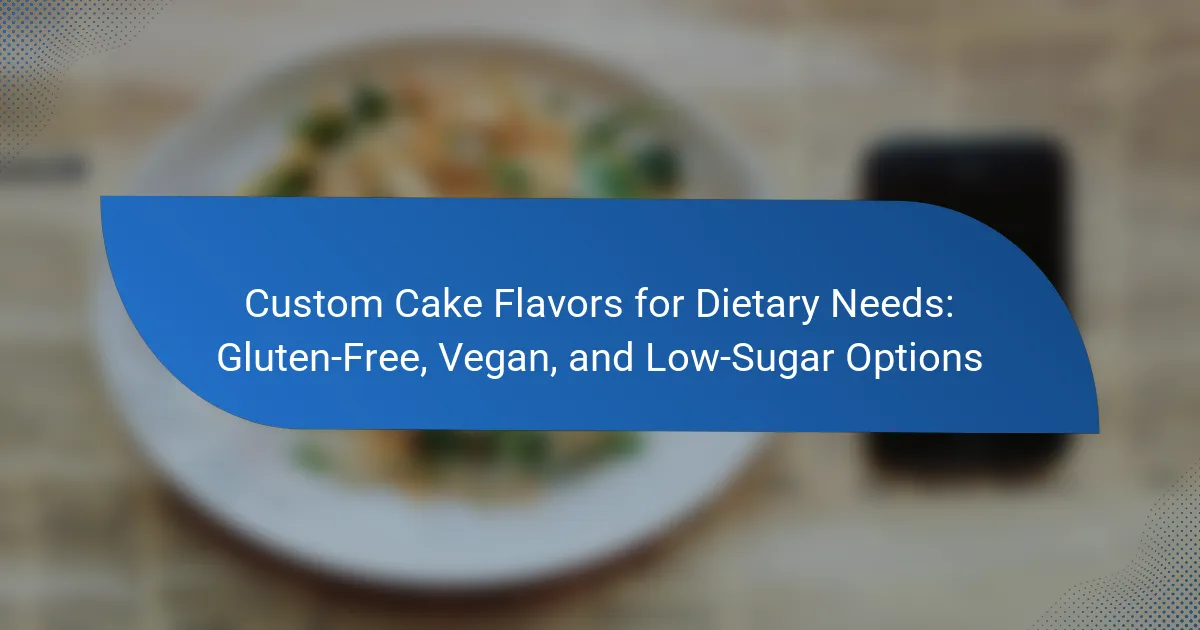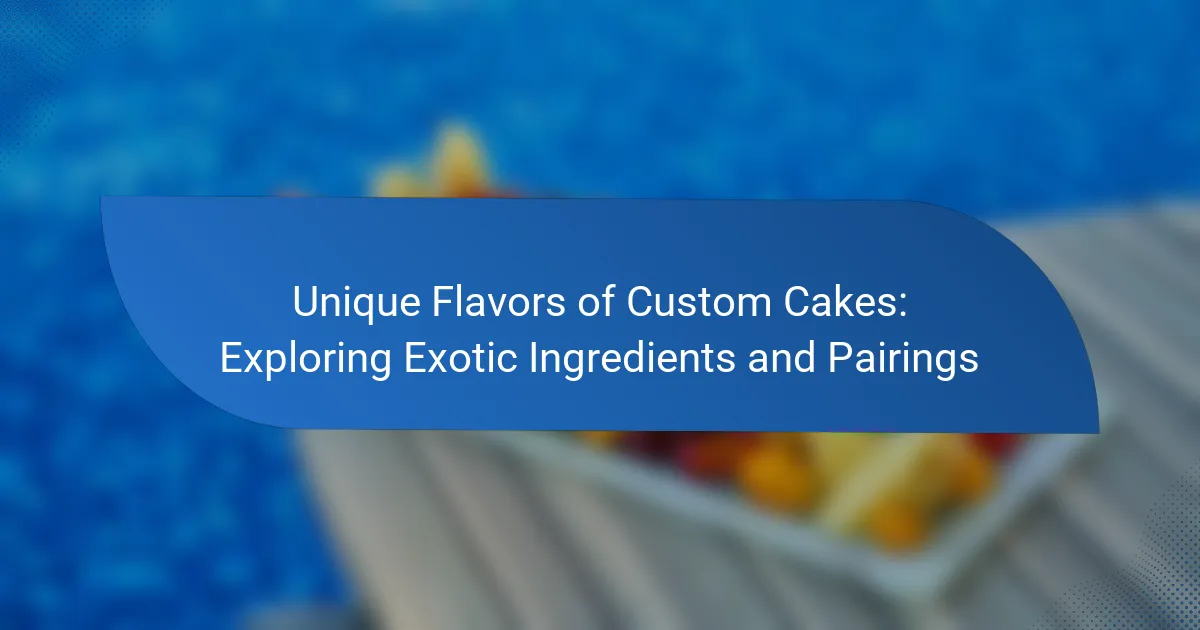Custom cake flavors are a key focus in the culinary world, with popular choices including vanilla, chocolate, red velvet, lemon, carrot, and funfetti. Vanilla is a versatile classic that complements a variety of fillings and frostings, while chocolate is renowned for its rich flavor. Red velvet stands out for its vibrant color and is typically paired with cream cheese frosting. Lemon offers a refreshing taste, carrot cake is appreciated for its moistness and spices, and funfetti adds a whimsical element with colorful sprinkles. These flavors are frequently requested for celebrations and special occasions, highlighting their significance in cake design and enjoyment.

What are Popular Custom Cake Flavors?
Popular custom cake flavors include vanilla, chocolate, and red velvet. Vanilla is a classic that pairs well with various fillings and frostings. Chocolate is favored for its rich taste and versatility. Red velvet, known for its striking color, often features cream cheese frosting. Other popular flavors include lemon, carrot, and funfetti. Lemon offers a refreshing zest, while carrot cake is beloved for its moist texture and spices. Funfetti adds a playful touch with colorful sprinkles. These flavors are commonly requested for celebrations and special occasions.
How do Classic Choices differ from Modern Twists in Cake Flavors?
Classic choices in cake flavors are traditional and well-established varieties. Examples include chocolate, vanilla, and red velvet. These flavors have been popular for decades and are often associated with classic recipes.
Modern twists in cake flavors introduce innovative ingredients and combinations. Examples include matcha green tea, salted caramel, and lavender. These flavors reflect contemporary culinary trends and experimentation.
The primary difference lies in the approach to flavor development. Classic choices focus on familiar tastes, while modern twists explore unique and adventurous profiles. This evolution caters to diverse palates and preferences in today’s baking culture.
What are the characteristics of Classic Cake Flavors?
Classic cake flavors are characterized by their timeless appeal and familiar ingredients. Common flavors include vanilla, chocolate, and red velvet. Vanilla cake is known for its light and airy texture, often enhanced with butter or cream. Chocolate cake features rich cocoa, providing a deep, indulgent taste. Red velvet cake is distinguished by its vibrant color and subtle cocoa flavor, typically paired with cream cheese frosting. These flavors often serve as bases for various frostings and fillings. Their popularity stems from their versatility and ability to complement a range of occasions. Classic cakes are frequently chosen for celebrations, weddings, and birthdays due to their widespread recognition and acceptance.
What defines Modern Twists in Cake Flavors?
Modern twists in cake flavors are characterized by innovative combinations and unconventional ingredients. These flavors often fuse traditional recipes with global influences. Ingredients like matcha, lavender, and salted caramel are commonly used. Unique flavor profiles such as spicy chocolate or citrus-infused cakes are also popular. The trend emphasizes bold tastes and unexpected pairings. Many modern cakes incorporate elements from desserts like cookies or pastries. For example, a cake may feature a filling inspired by tiramisu or a topping reminiscent of a cheesecake. Overall, modern twists reflect a creative approach to flavor that resonates with contemporary palates.
Why are Custom Cake Flavors important for Celebrations?
Custom cake flavors are important for celebrations because they enhance personalization and create memorable experiences. Tailoring flavors to individual preferences allows hosts to cater to the tastes of guests. This customization fosters a sense of inclusion and enjoyment during the event. Unique flavors can also serve as conversation starters, making the celebration more engaging. Additionally, diverse options can accommodate dietary restrictions, ensuring all attendees can partake. According to a survey by The Knot, 80% of couples choose custom cakes to reflect their personalities. This statistic underscores the significance of custom flavors in creating a unique celebration.
How do Custom Cake Flavors enhance the overall experience of an event?
Custom cake flavors enhance the overall experience of an event by providing unique and personalized options for guests. These flavors cater to diverse palates and preferences, making each event memorable. Customization allows hosts to reflect themes or personal stories through flavor choices. For instance, a chocolate raspberry cake can evoke romantic sentiments for weddings. Offering a variety of flavors can also encourage social interaction among guests as they share their favorites. Additionally, unique flavors can create a talking point, enhancing the event’s atmosphere. According to a survey by The Knot, 70% of couples believe that cake flavor is a critical aspect of their wedding reception. This statistic highlights the importance of flavor in event enjoyment.
What role do Custom Cake Flavors play in personalizing celebrations?
Custom cake flavors play a significant role in personalizing celebrations. They allow hosts to reflect individual tastes and preferences. Custom flavors can cater to specific dietary restrictions or preferences, such as gluten-free or vegan options. This personalization enhances the overall celebration experience. Unique flavors can also create memorable moments for guests. For example, a chocolate raspberry cake may evoke fond memories for someone. Additionally, custom flavors can align with the theme of the event. This alignment fosters a cohesive atmosphere. Overall, custom cake flavors contribute to the uniqueness and enjoyment of celebrations.
What are the most popular Classic Cake Flavors?
The most popular classic cake flavors include vanilla, chocolate, and red velvet. Vanilla cake is favored for its versatility and ability to pair well with various frostings. Chocolate cake is beloved for its rich taste and moist texture. Red velvet cake stands out due to its unique color and subtle cocoa flavor. Other notable mentions are lemon and carrot cakes, both appreciated for their distinct flavors. These flavors have remained favorites in bakeries and celebrations for decades.
What ingredients are commonly used in Classic Cake Flavors?
Common ingredients in classic cake flavors include flour, sugar, eggs, and butter. These ingredients form the base of most cake recipes. Vanilla extract is often added for flavor. Baking powder is used as a leavening agent. Milk or buttermilk provides moisture and richness. Cocoa powder is essential for chocolate cakes. Fruits like lemon or bananas can enhance flavor profiles. Specific combinations of these ingredients create distinct cake varieties, such as vanilla, chocolate, and lemon cakes.
How do Classic Cake Flavors appeal to different taste preferences?
Classic cake flavors appeal to different taste preferences by offering a variety of taste profiles. Flavors like vanilla provide a sweet, neutral base that complements many fillings and frostings. Chocolate offers a rich, indulgent option that satisfies cravings for something decadent. Red velvet combines mild cocoa with cream cheese, appealing to those who enjoy a unique texture and flavor. Lemon cake caters to those who prefer a tangy and refreshing taste. Each classic flavor serves as a versatile foundation for personalization, allowing bakers to create custom cakes that resonate with individual preferences. This adaptability is supported by consumer surveys indicating that classic flavors remain among the most requested options for celebrations.
What are the trending Modern Cake Flavors?
Trending modern cake flavors include matcha, lavender, and salted caramel. Matcha offers a unique earthy taste and vibrant green color. Lavender provides a floral note, appealing to those seeking aromatic desserts. Salted caramel combines sweet and savory, creating a rich flavor profile. Other popular choices are lemon elderflower and chocolate chili. Lemon elderflower is refreshing and light, perfect for spring celebrations. Chocolate chili adds a spicy kick to traditional chocolate cake. These flavors reflect current culinary trends emphasizing unique and bold tastes.
What unique ingredients are being incorporated into Modern Cake Flavors?
Unique ingredients being incorporated into modern cake flavors include matcha, lavender, and cardamom. Matcha adds a vibrant green color and earthy flavor. Lavender provides a floral note that enhances sweetness. Cardamom introduces a warm, spicy element that complements various cake bases. Other unique ingredients are olive oil, which adds moisture and richness, and exotic fruits like passionfruit and yuzu, offering tangy and refreshing flavors. These ingredients reflect contemporary baking trends that prioritize bold, diverse flavors.
How do cultural influences shape Modern Cake Flavors?
Cultural influences shape modern cake flavors by introducing diverse ingredients and techniques. Globalization allows for the fusion of traditional recipes with contemporary tastes. For example, Asian flavors like matcha and red bean are increasingly popular in Western cakes. Additionally, spices from Middle Eastern cuisines, such as cardamom and saffron, enhance flavor profiles. Regional celebrations also inspire cake flavors, reflecting local customs and preferences. The rise of social media amplifies these trends, showcasing unique creations and encouraging experimentation. This blend of cultures results in innovative cake flavors that appeal to a broader audience.
How can you choose the right Custom Cake Flavor for your event?
To choose the right custom cake flavor for your event, consider the preferences of your guests. Gather information on popular flavors such as chocolate, vanilla, and red velvet. Assess the theme of your event, as certain flavors may complement it better than others. Take into account any dietary restrictions, like gluten-free or vegan options. Conduct a taste test with a few selected flavors to see which ones resonate best. Additionally, consider seasonal ingredients that may enhance flavor profiles. Finally, consult with a professional baker for recommendations based on current trends and flavor combinations.
What factors should you consider when selecting a Cake Flavor?
Consider the occasion when selecting a cake flavor. Different events may call for specific tastes. For example, chocolate is popular for birthdays, while vanilla suits weddings.
Next, think about the preferences of the guests. Knowing their likes and dislikes can guide your choice. Allergies also play a crucial role. Common allergens include nuts and gluten.
The season can influence flavor selection too. Light flavors like lemon are refreshing in summer. Rich flavors like spice cake are comforting in winter.
Lastly, consider the cake’s design and theme. The flavor should complement the visual presentation. A cohesive flavor and design enhance the overall experience.
How can you incorporate guest preferences into your Cake Flavor choice?
To incorporate guest preferences into your cake flavor choice, gather feedback from your guests. Conduct surveys or polls to identify popular flavors among your audience. Analyze dietary restrictions, such as allergies or preferences for vegan or gluten-free options. Consider seasonal flavors that align with the event’s timing. Offer a tasting session for guests to sample and vote on their favorites. Use social media to engage guests and solicit their input on flavor combinations. This approach ensures the chosen flavor resonates with your guests’ tastes. Ultimately, tailoring the cake flavor to guest preferences enhances their overall experience.
Popular custom cake flavors encompass a range of classic choices and modern twists, including traditional flavors like vanilla, chocolate, and red velvet, as well as innovative options such as matcha, salted caramel, and lavender. The article explores the characteristics of classic cake flavors, their appeal for various occasions, and the significance of customization in enhancing celebration experiences. Additionally, it examines how cultural influences shape modern cake flavors and provides guidance on selecting the right flavor based on guest preferences and event themes. Overall, the content highlights the evolving landscape of cake flavors in contemporary baking culture.



